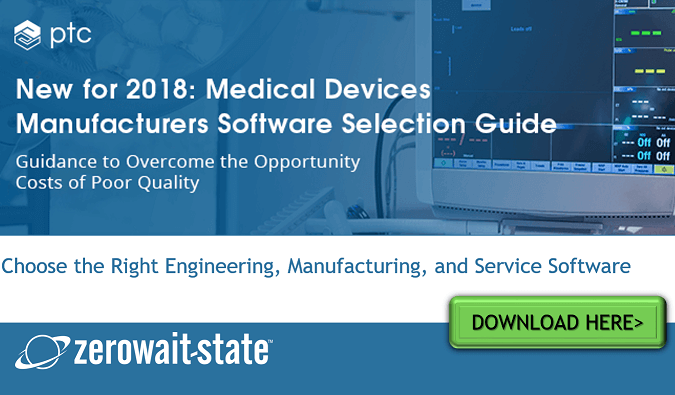Welcome to this week's TBT blog!
I selected this one from PTC since we're partnering to deliver
the latest PLM and IoT technology to the medical device industry.
This blog was originally published on ptc.com; authored by Michelle Boucher.
Medical device companies are in the rewarding business of making people’s lives better. As technology evolves, new innovative approaches provide patients with treatments that can result in an improved quality of life. While this offers exciting opportunities, medical device companies must be very careful to avoid recalls.
The Cost of Recalls
 Recalls pose a significant challenge for the Medical Device industry. The FDA Medical Device Recall Report, FY 2003 to FY 2012 finds that the annual number of medical device recalls increased by a shocking 97 percent from 2003 to 2012. This increase highlights the considerable problem that all medical device companies face and must worker harder avoid. The FDA report also states that the most frequent causes for recalls are related to device design, software, and non-conforming material or component issues. It follows then that investments to improve the process for developing medical devices could have a significant impact on reducing the number of recalls.
Recalls pose a significant challenge for the Medical Device industry. The FDA Medical Device Recall Report, FY 2003 to FY 2012 finds that the annual number of medical device recalls increased by a shocking 97 percent from 2003 to 2012. This increase highlights the considerable problem that all medical device companies face and must worker harder avoid. The FDA report also states that the most frequent causes for recalls are related to device design, software, and non-conforming material or component issues. It follows then that investments to improve the process for developing medical devices could have a significant impact on reducing the number of recalls.
You may wonder, does the potential cost of a recall justify making such an investment? It most certainly does. In their study, The Business Case for Medical Device Quality, McKinsey estimates that non-routine quality events, such as major observations, recalls, warning letters, and consent decrees, along with associated warranties and lawsuits, cost the industry between $2.5 billion and $5 billion per year, on average. Beyond the initial cost of the recall, the brand reputation also suffers. McKinsey found that there is long-term destruction of value. After a single major quality event, such as a major product recall, an average of one company per year has seen a 10 percent drop in share price over the past decade. This is extremely difficult to recover from. In fact, a small company may not even have the resources to survive it. Given the high cost, McKinsey says this should force companies to focus on quality and reliability throughout product design, manufacturing, and marketing.
between $2.5 billion and $5 billion per year, on average. Beyond the initial cost of the recall, the brand reputation also suffers. McKinsey found that there is long-term destruction of value. After a single major quality event, such as a major product recall, an average of one company per year has seen a 10 percent drop in share price over the past decade. This is extremely difficult to recover from. In fact, a small company may not even have the resources to survive it. Given the high cost, McKinsey says this should force companies to focus on quality and reliability throughout product design, manufacturing, and marketing.
So where should a company focus to reduce the number of recalls? For their report, Medical Device Recall Report, the FDA categorized the cause of recalls from FY 2010 to FY 2012. They found that 36% of recalls are due to design related failures, the largest cause of recalls. It follows that improving the quality of the design would have the biggest impact on reducing the number of recalls. Another 17% of recalls come from problems with process control so better management across the product lifecycle, with a focus on quality should greatly reduce recalls.
So how can companies focus on quality and reliability during design and manufacturing? So many resources are already focused on compliance. Competitive time-to-market pressures mean more time cannot be added to the development process. Complex supply chains are already difficult to manage. How can medical device companies possibly add more to development responsibilities, without letting something else suffer?
Shift from Document-Centric to Product-Centric
 The answer lies in a shift from document-centric processes to product focused processes. Rather than structuring processes around all the documentation required for compliance, structure processes around the medical device and tracing everything from the patient, to requirements, design, test, manufacturing, and servicing of the device, while also keeping tight controls on suppliers. This can be accomplished more easily with the use of technology. With the right technology, you gain traceability across the product lifecycle, from concept to service. With traceability, required compliance documentation and reports are exported with the press of a button rather than manually searching through documents. This way, you are actually more efficient and you can use that time to focus on innovation and quality, rather than documentation.
The answer lies in a shift from document-centric processes to product focused processes. Rather than structuring processes around all the documentation required for compliance, structure processes around the medical device and tracing everything from the patient, to requirements, design, test, manufacturing, and servicing of the device, while also keeping tight controls on suppliers. This can be accomplished more easily with the use of technology. With the right technology, you gain traceability across the product lifecycle, from concept to service. With traceability, required compliance documentation and reports are exported with the press of a button rather than manually searching through documents. This way, you are actually more efficient and you can use that time to focus on innovation and quality, rather than documentation.
Finally, traceability means you trace requirements all the way from the design details to the test and confirm that the requirement is verified and validated. This way, you make sure everything has been tested. When a test fails, you can trace it to the root cause and fix it. You can also make sure everything impacted by the fix is also updated.
Solution Buying Criteria for a Medical Device Company
To achieve such a high level of traceability, you should consider a solution for the entire lifecycle, across all aspects of development. Your solution should allow you to:
- • Manage the Product
- • Manage Requirements
- • Support Product Development for Hardware
- • Support Software Development
- • Enable Smart and Connected Products
- • Ensure Regulatory Compliance
- • Support Quality Management
- • Plan for Manufacturing
- • Control Suppliers
- • Plan for Service

In some cases, you may have solutions that already work well. If that is the case, another important part of the buying criteria should be a platform that allows you to leverage and extend the investments made in existing solutions. With investments in the right technology, your company is better positioned to ensure quality and avoid costly recalls.
Author: Michelle Boucher is the Vice President of Research for Engineering Software for research firm Tech-Clarity.
[Edit: repost from ptc.com]



